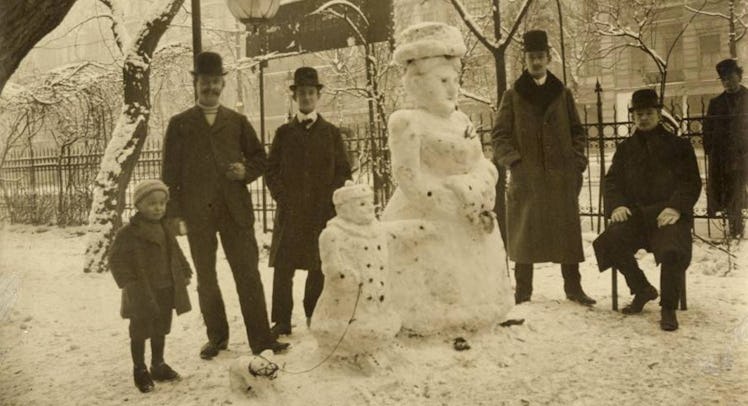The True, Weird History Of Where The Snowman Came From
It wasn't always corncob pipes and 2 eyes made out of coal.

You know Frosty, Olaf, Crystal. You’re probably familiar with The Bumble, Marshmallow and other such abominable sorts, too. That’s because snowmen are the head honcho of the holidays, a winter symbol used to sell everything under the (not-too-hot) sun. But what do you really know about the frosty men (and women) outside of their corncob pipes, magical top hats, and ear-splitting Beach Boys‘ covers?
Bob Eckstein was curious. And as it turns out the snowman has a long, storied history that goes far beyond coal eyes and carrot noses. In 2007, after 7 years of research, the illustrator, New Yorker cartoonist, and humorist wrote The History of the Snowman. Here, Eckstein, whose latest book is the Footnotes from the World’s Greatest Bookstores, offers some insight into early snowman rituals, why Frosty is a fraud, and a dynamite-fueled snowman festival where icy heads roll.
Snowman Persecution Goes Way Back
Man always loved stacking things; cave drawings make this clear. Knowing this, Eckstein says it’s likely that Neanderthals were constructing crude snowmen. The earliest documented snowman he did find was in an illuminated manuscript dating back to 1380. Unfortunately, the drawing found in the margins of the Book of Hours, a Christian prayer devotional, wasn’t very PC.
The Rebellion Of Snowy Sex Acts
“Snowmen are a part of many historical benchmarks,” says Eckstein. “They’re like frozen Forrest Gumps.” The Miracle of 1511 is one of the most entertaining. That year, the townsfolk of Brussels put on a mini-Woodstock, protesting the political climate using the art supply that fell from the sky. The citizenry constructed life-sized snow statues on every street corner, which included politically-charged displays and some XXX scenes.
Some Artists Appealed To Our Better Snow Angels
Fine artists often used the snowman to flex their creative muscles. One famous example: On the morning of New Year’s Day 1857, sculptor Larkin Mead (who, by the way, designed Abraham Lincoln’s Springfield tomb) unveiled an 8-foot high snow-and-ice statue in Brattleboro, Vermont. The heavenly figure held a pen and paper so it became known as the “Recording Angel.” It was said to be so lifelike, schoolboys refrained from pelting it with snowballs. The New York Tribune sent a reporter to cover it, the image went worldwide, and Mead became a national phenomenon. See? Viral images were a thing back in the 1800’s, too.
Frosty The Snowman Is A Con Artist
“Everything went to pot when Frosty the Snowman came out and snowmen became something for children instead of folk art,” laments Eckstein. What was once the province of Michelangelo would devolve into a fun 1950 Gene Autry hit, a pleasant 1954 short, and the 1969 Jimmy Durante-voiced cartoon. What’s never acknowledged, however, is Ruth Herman’s 1944 book Snowy, the Traveling Snowman, which features a magical singing snowman and all of Frosty’s features. “She didn’t get any credit or any royalties, the songwriters ripped her off right down to the bumpity-bump-bumps,” says Eckstein.
Around The World In Snowmen
Not all snow-creations come with corncob pipes. In Japan, snowmen are made with two balls, one big and one small atop it, and without arms. They are to resemble the daruma doll, which brings good luck. In China, going back to the 7th-century, Buddha statues are carved out of snow for families to worship in place of marble or wood.
Less holy, but way more fun, is the Zurich Switzerland festival of Sechseläuten, which features the Böögg, a snowman stuffed with straw, cotton, and dynamite. On the third Monday in April, after being paraded through town, the Böögg is set aflame. The faster its head explodes, the better the warm weather to come. It’s like Groundhog Die Hard Day.
Do You Wanna Build A Snowman?
“To make a good snowman, you need humidity,” says Eckstein. “The air in the North Pole is too dry. Eskimos have to frequently try multiple times when constructing igloos.” In other words? Elf himself sits on a throne of lies. Is nothing sacred? Now go keep the tradition alive.
This article was originally published on